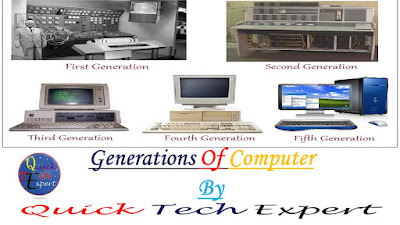Generations Of Computer : With Short Notes In English And Hindi Both Languages
Computer :
A computer is a programmable device with a set of instructions to perform specific tasks and generate results at a very high speed . A computer is an electronic machine that can solve different problems , process data , stores and retrives data and performs calculations faster and efficiently than humans .
A computer is an electronic machine that accepts informations , stores it , process it , according to the instructions provided by a user and then Returns the Result . Computer Is An Electronic Machine or device for performing arithmetical and logical operations . Computer is a device to process data and converts it into informations .
कंप्यूटर एक प्रोग्राम करने योग्य उपकरण है जिसमें विशिष्ट कार्यों को करने और बहुत तेज़ गति से परिणाम उत्पन्न करने के लिए निर्देशों का एक सेट होता है। कंप्यूटर एक इलेक्ट्रॉनिक मशीन है जो विभिन्न समस्याओं को हल कर सकती है, डेटा को संसाधित कर सकती है, डेटा को संग्रहीत और पुनः प्राप्त कर सकती है और मनुष्यों की तुलना में तेजी से और कुशलता से गणना करती है।
कंप्यूटर एक इलेक्ट्रॉनिक मशीन है जो उपयोगकर्ता द्वारा दिए गए निर्देशों के अनुसार सूचनाओं को स्वीकार करता है, संग्रहीत करता है, संसाधित करता है और फिर परिणाम देता है। कंप्यूटर अंकगणितीय और तार्किक संचालन करने के लिए एक इलेक्ट्रॉनिक मशीन या उपकरण है। कंप्यूटर डेटा को प्रोसेस करने और उसे सूचनाओं में परिवर्तित करने वाला एक उपकरण है।
Generations Of Computer :
There are Five Generations of computer :--> First Generation (1940 To 1956)
--> Second Generation (1956 To 1963)
--> Third Generation (1964 To 1971)
--> Fourth Generation (1971 To 2010)
--> Fifth Generation (Artificial Intelligence)
कंप्यूटर की पाँच पीढ़ियाँ हैं:
--> पहली पीढ़ी (1940 से 1956)
--> दूसरी पीढ़ी (1956 से 1963)
--> तीसरी पीढ़ी (1964 से 1971)
--> चौथी पीढ़ी (1971 से 2010)
--> पांचवीं पीढ़ी (कृत्रिम बुद्धिमत्ता)
As we Know that in earlier time a computer is very dummy device so researches are on spot working and
after
researches and time passed the device of more suitable and reliable machine was need which could perform
our
work more quickly .
During This Time in year 1946 the first successful electronic computer called
ENIAC was
developed and it was the starting point of the current generation of computers .
जैसा कि हम जानते हैं कि पहले के समय में कंप्यूटर एक बहुत ही डमी डिवाइस होता था इसलिए रिसर्च ऑन स्पॉट
वर्किंग
होती थी और रिसर्च और समय बीतने के बाद अधिक उपयुक्त और विश्वसनीय मशीन की आवश्यकता थी जो हमारे काम को और
अधिक
तेज़ी से कर सके।
इस समय के दौरान वर्ष 1946 में ENIAC नामक पहला सफल इलेक्ट्रॉनिक कंप्यूटर
विकसित किया गया था और यह
कंप्यूटर की वर्तमान पीढ़ी का प्रारंभिक बिंदु था।
First Generation (1940 To 1956) :
ENIAC was the world first successfull electronic computer which was developed by the two scientists
namely J.P. Eckert And J.W. Mauchy.
It was the beginning of first generation computer extremely large in size .
The full form of ENIAC Is Electronic Numeric Integreted and Calculator
ENIAC was very huge and big computer its weight was 30 tones .
It could store only limited or small amount of informations .
Initially in the first generation computer the concept of vaccum tubes was used.
A vaccum tubes was such an electronic component which had less work efficiency and so it could not work
properly and it required a large cooling system.
Produced so much heat they regularly overheated despite cooling units .
At Conclusion First Generation of Computer mainly works on concept of
vaccum tubes .
ENIAC दुनिया का पहला सफल इलेक्ट्रॉनिक कंप्यूटर था जिसे दो वैज्ञानिकों जे.पी. एकर्ट और जे.डब्ल्यू. द्वारा
विकसित किया गया था। मौची। यह पहली पीढ़ी के बेहद बड़े आकार के कंप्यूटर की शुरुआत थी।
ENIAC का फुल फॉर्म इलेक्ट्रॉनिक न्यूमेरिक इंटीग्रेटेड और कैलकुलेटर है ENIAC बहुत ही विशाल और बड़ा
कंप्यूटर था इसका वजन 30 टन था।
यह केवल सीमित या छोटी मात्रा में ही जानकारी संग्रहीत कर सकता है। प्रथम पीढ़ी के कंप्यूटर में प्रारंभ में
वैक्यूम ट्यूब की अवधारणा का उपयोग किया गया था। वैक्यूम ट्यूब एक ऐसा इलेक्ट्रॉनिक घटक था जिसकी कार्य
क्षमता कम थी और इसलिए यह ठीक से काम नहीं कर पाता था और इसके लिए एक बड़े शीतलन प्रणाली की आवश्यकता होती
थी। इतनी अधिक गर्मी पैदा की कि यूनिटों को ठंडा करने के बावजूद वे नियमित रूप से ज़्यादा गरम हो गए।
निष्कर्ष के तौर पर कंप्यूटर की पहली पीढ़ी मुख्य रूप से वैक्यूम ट्यूब की अवधारणा पर काम करती है।
Second Generation (1956 To 1963) :
in this generation , transistors were used as the electronic component instead of vaccum tubes
A transistor is much smaller in the size than that of a vaccum tube.
as the size of electrons components decreased the size of computer also decreased .
it became much smaller than that of earlier computer .
At Conclusion Second generation of computer mainly works on concept of
transistors
इस पीढ़ी में, वैक्यूम ट्यूब के बजाय ट्रांजिस्टर को इलेक्ट्रॉनिक घटक के रूप में उपयोग किया जाता था |
एक ट्रांजिस्टर एक वैक्यूम ट्यूब की तुलना में आकार में बहुत छोटा होता है। जैसे-जैसे इलेक्ट्रॉन घटकों का आकार घटता गया, कंप्यूटर का आकार भी घटता गया। यह पहले के कंप्यूटर से काफी छोटा हो गया।
निष्कर्षतः कंप्यूटर की दूसरी पीढ़ी मुख्य रूप से ट्रांजिस्टर की अवधारणा पर काम करती है
Third Generation (1964 To 1971) :
First developed by T.S. Kilby
integrated circuit development was the hallmark of the third generation of Computers
integrated circuits , or semiconductors chips , were large number of manufacture transistors packed on
silicon chips.
there were drastic increased in the speed and efficiency of computers .
transistors are fabricated on tiny silicon chips .
Development of ic integrated circuits gave birth to a new field of microelectronics
main advantages of ic is not only its tiny size but its superior performance and reliability than the
previous circuits .
This Generation of computers has huge storage capacity and higher calculating speed.
At Conclusion Third Generation Of Computers mainly works on concept of
Integrated circuits
सबसे पहले टी.एस. द्वारा विकसित किल्बी इंटीग्रेटेड सर्किट डेवलपमेंट कंप्यूटर की तीसरी पीढ़ी की पहचान थी इंटीग्रेटेड सर्किट, या सेमीकंडक्टर चिप्स, सिलिकॉन चिप्स पर पैक किए गए बड़ी संख्या में निर्मित ट्रांजिस्टर थे।
कंप्यूटर की गति और दक्षता में भारी वृद्धि हुई। ट्रांजिस्टर छोटे सिलिकॉन चिप्स पर निर्मित होते हैं। आईसी इंटीग्रेटेड सर्किट के विकास ने माइक्रोइलेक्ट्रॉनिक्स के एक नए क्षेत्र को जन्म दिया, आईसी का मुख्य लाभ न केवल इसका छोटा आकार है, बल्कि पिछले सर्किट की तुलना में इसका बेहतर प्रदर्शन और विश्वसनीयता भी है। कंप्यूटर की इस पीढ़ी में विशाल भंडारण क्षमता और उच्च गणना गति है।
निष्कर्ष के तौर पर कंप्यूटर की तीसरी पीढ़ी मुख्य रूप से इंटीग्रेटेड सर्किट की अवधारणा पर काम करती है
Fourth Generation (1971 To 2010) :
Mainly of transistors fabricated on a single circuit chip which is also called Monolithic integrated circuit technology
also heralded the invention of the intel 4004 chip which was the first , microprocessor to become
commercial available in 1971 .
A microprocessor is a single chip (LSI circuit) which is used in a computer
for arithmetical or logical functions to be performed in any program . Graphical User
Interface invented during this Time.
At Conclusion Fourth generation computers mainly works on the concept of
Monolithic integrated circuit technology
मुख्य रूप से सिंगल सर्किट चिप पर निर्मित ट्रांजिस्टर, जिसे मोनोलिथिक इंटीग्रेटेड सर्किट टेक्नोलॉजी भी कहा जाता है, ने इंटेल 4004 चिप के आविष्कार की शुरुआत की, जो 1971 में वाणिज्यिक रूप से उपलब्ध होने वाला पहला माइक्रोप्रोसेसर था।
माइक्रोप्रोसेसर एक एकल चिप (एलएसआई सर्किट) है जिसका उपयोग कंप्यूटर में किसी भी प्रोग्राम में किए जाने वाले अंकगणितीय या तार्किक कार्यों के लिए किया जाता है। इसी दौरान ग्राफ़िकल यूज़र इंटरफ़ेस का आविष्कार हुआ।
निष्कर्ष के तौर पर चौथी पीढ़ी के कंप्यूटर मुख्य रूप से मोनोलिथिक इंटीग्रेटेड सर्किट टेक्नोलॉजी की अवधारणा पर काम करते हैं
Fifth Generation (Artificial Intelligence) :
Current Technology trend in computing devices are based on quantum computation , molecular ,
nanotechnology and Artificial Intelligence are still in development
Fifth Generation of computers has yet to be truly defined , as there are numerous paths that
technologies is taking forward the future of computer development .
At Conclusion Fifth Generation of computers mainly works on the concept of
quantum computation , molecular , nanotechnology and Artificial Intelligence are still in
development
कंप्यूटिंग उपकरणों में वर्तमान प्रौद्योगिकी प्रवृत्ति क्वांटम गणना पर आधारित है, आणविक, नैनो प्रौद्योगिकी और कृत्रिम बुद्धिमत्ता अभी भी विकास में हैं। कंप्यूटर की पांचवीं पीढ़ी को अभी तक सही मायने में परिभाषित नहीं किया जा सका है, क्योंकि ऐसे कई रास्ते हैं जो प्रौद्योगिकियां कंप्यूटर विकास के भविष्य को आगे ले जा रही हैं।
निष्कर्ष में कंप्यूटर की पांचवीं पीढ़ी मुख्य रूप से क्वांटम गणना की अवधारणा पर काम करती है, आणविक, नैनो प्रौद्योगिकी और कृत्रिम बुद्धिमत्ता अभी भी विकास में हैं
In Short We Can Understand Generations Of Computers By Table Given Below : Short Notes
| Generation | Duration | Memory Devices |
|---|---|---|
| First Generation | (1940 To 1956) | Vaccum tubes |
| Second Generation | (1956 To 1963) | Transistors |
| Third Generation | (1964 To 1971) | Integrated Circuit(LSI Large Scale Integrated Circuit) |
| Fourth Generation | (1971 To 2010) | Integrated Circuit(VLSI Very Large Scale Integrated Circuit) |
| Fifth Generation | (2010 onwards) | Biochips (Concept Of Artificial Intelligence) |















0 Comments